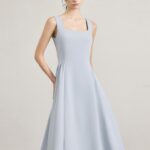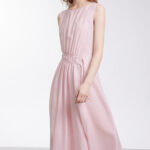The Allure of Traditional Asian Attire: Hanfu and Hanbok
The rich tapestry of Asian culture is woven with threads of tradition, history, and elegance. Among the most vibrant of these threads are the traditional garments known as Hanfu and Hanbok. These garments are more than mere clothing; they are embodiments of cultural identity, historical significance, and aesthetic beauty. As we embark on a comparative journey through the styles and elegance of Hanfu and Hanbok, we delve into the difference between hanfu and hanbok, exploring their unique characteristics and the cultural narratives they represent.

Hanfu: The Timeless Elegance of Chinese Tradition
Hanfu, the traditional clothing of the Han Chinese, dates back to the Yellow Emperor and has evolved through various dynasties. It’s characterized by its flowing sleeves, cross-collar, and a front-tie sash, reflecting the philosophy of harmony between humans and nature. Each fold and seam of Hanfu tells a story of ancient China’s social hierarchy, cultural values, and artistic sensibilities. As Confucius once said, “When you wear the right attire, you carry the weight of culture and tradition.”

Hanbok: The Graceful Lines of Korean Heritage
Hanbok, the traditional attire of Korea, is known for its vibrant colors and elegant lines. It features a fitted top and a full, often pleated skirt, symbolizing the grace and poise of the Korean people. The intricate patterns and the choice of colors in Hanbok are deeply rooted in the country’s social customs and beliefs. A statement by a renowned Korean fashion historian highlights the essence of Hanbok: “It is not just a garment; it is the spirit of Korea, a living testament to our rich heritage.”

Exploring the Difference Between Hanfu and Hanbok
While both Hanfu and Hanbok share the common thread of being traditional Asian garments, they exhibit distinct differences in design, cultural significance, and social implications. Hanfu is often associated with the grandeur of ancient Chinese dynasties, whereas Hanbok reflects the refined elegance of the Korean court and common folk. The difference between hanfu and hanbok is not merely in appearance but also in the stories they convey and the values they uphold.

Cultural Revival and Modern Interpretations
The resurgence of interest in Hanfu and Hanbok is not just a nostalgic look back but also a forward step in embracing cultural heritage in the modern world. Fashion shows, cultural festivals, and social media platforms are alive with the vibrant colors and flowing lines of these traditional garments. As a fashion blogger on YouTube noted, “Hanfu and Hanbok are not just clothing; they are a connection to our roots, a celebration of our past, and a statement of our identity in the present.”

Conclusion: The Harmony of Tradition and Innovation
The journey through the styles and elegance of Hanfu and Hanbok is more than a visual feast; it’s an exploration of cultural depth and historical continuity. As we appreciate the difference between hanfu and hanbok, we also recognize the harmony that can be achieved by blending tradition with innovation. Whether it’s the intricate embroidery on a Hanfu sleeve or the vibrant colors of a Hanbok skirt, each element is a testament to the enduring legacy of these traditional garments.







As a fashion designer, I find the revival of Hanfu and Hanbok inspiring. The difference between Hanfu and Hanbok is clear in their styles, but both offer endless possibilities for modern reinterpretations.
I’m a high school teacher in South Korea, and I find the comparison between Hanfu and Hanbok fascinating. The difference between Hanfu and Hanbok is clear, but both garments are a celebration of cultural diversity.
As a traveler, I’ve had the opportunity to see both Hanfu and Hanbok in person. The difference between Hanfu and Hanbok is striking, but both are equally beautiful and culturally significant.
I’m a high school teacher in the United States, and I find the comparison between Hanfu and Hanbok fascinating. The difference between Hanfu and Hanbok is clear, but both garments are a celebration of cultural diversity.